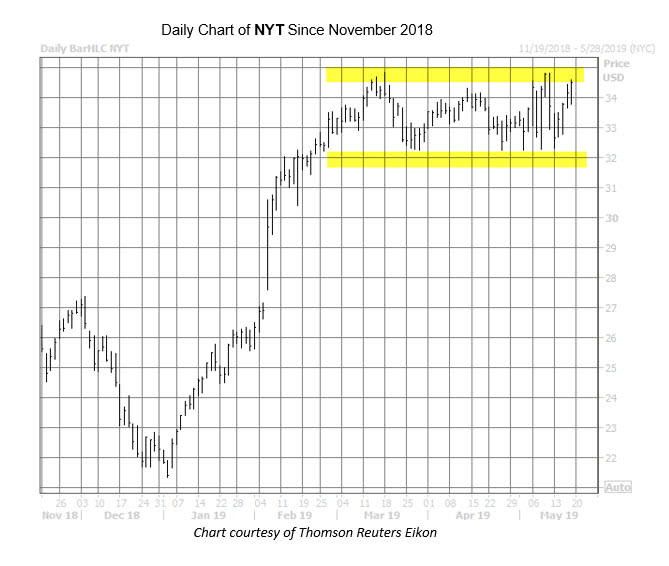Signal Flashing for NYT Stock Could Mean Fresh Highs
News and publishing stock New York Times Co (NYSE:NYT) has been consolidating atop support in the $32 region since rallying to decade-plus highs in March. Specifically, the stock hit a 13-year high of $34.85 on March 18, but has since struggled to overcome this area. However, NYT just flashed a historically bullish signal, suggesting the media stock might be on the cusp of a breakout.

NYT is up 1% at $34.50, at last check. Plus, the security's Schaeffer's Volatility Index (SVI) of 26% is in the low 7th percentile of its annual range, suggesting near-term options are attractively priced.
There have been four other times since 2008 when New York Times stock was trading near 52-week highs while simultaneously sporting an SVI in the bottom 20th percentile of its annual range. NYT was higher one month later after three of the four signals, averaging a 7.58% gain, according to Schaeffer's Senior Qualitative Analyst Rocky White. A similar move would have the stock trading in new-high territory in the $37 region.
Besides the fact that options are pricing in relatively low volatility expectations, NYT tends to exceed those expectations, as evidenced by its Schaeffer's Volatility Scorecard (SVS) of 83 out of a possible 100. This means the stock has made bigger moves than the options market has priced in during the past year.
Meanwhile, NYT could score some analyst upgrades or bullish initiations, should the equity once again break out to the upside. Only three brokerage firms currently follow the shares, and one of them considers the security a "strong sell." What's more, the stock's consensus 12-month target price of $33.75 is at a slight discount to current levels.
A short squeeze could be in the cards for New York Times stock, too. While short interest decreased by 5.3% in the last two reporting periods, the 5.66 million shares sold short still represent roughly 12% of the stock's available float. At the security's average pace of trading, it would take nearly two weeks to buy back all these bearish bets, a move that could put even more wind at NYT's back.

